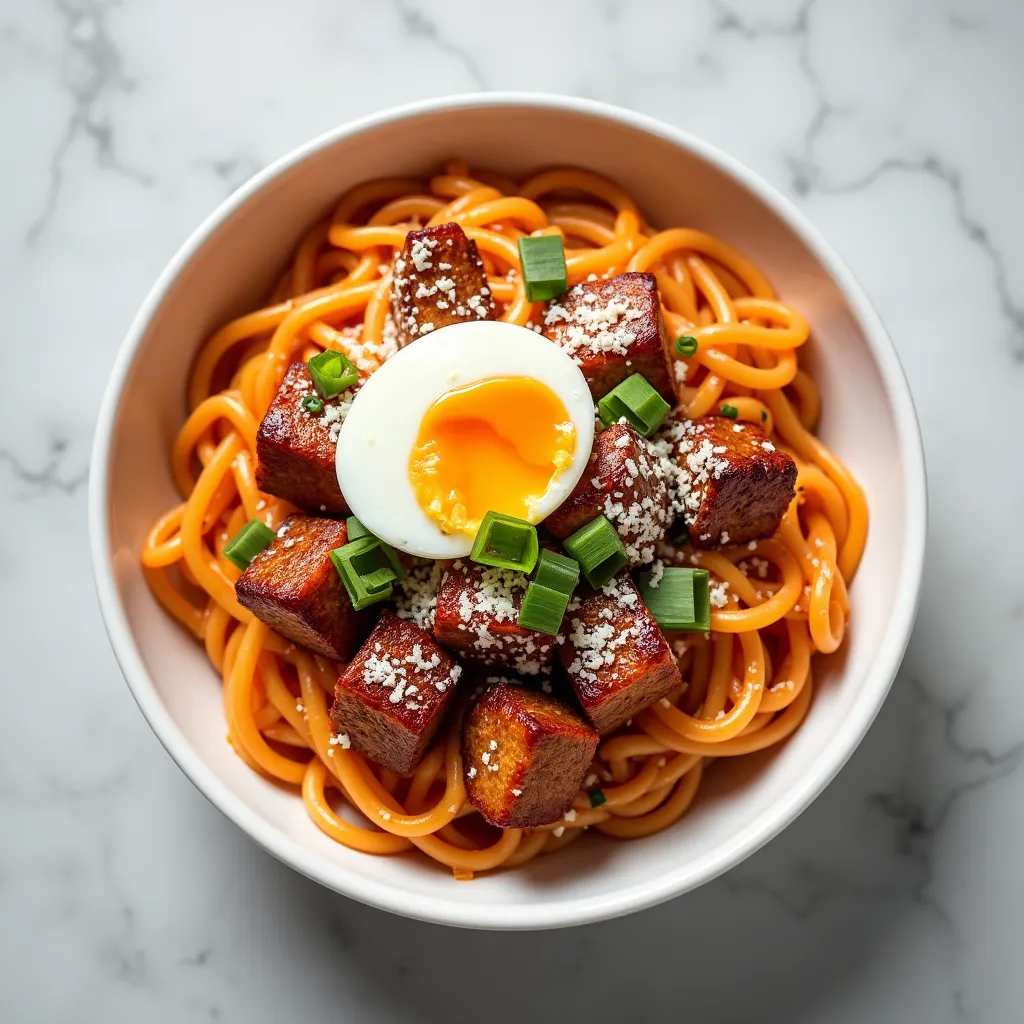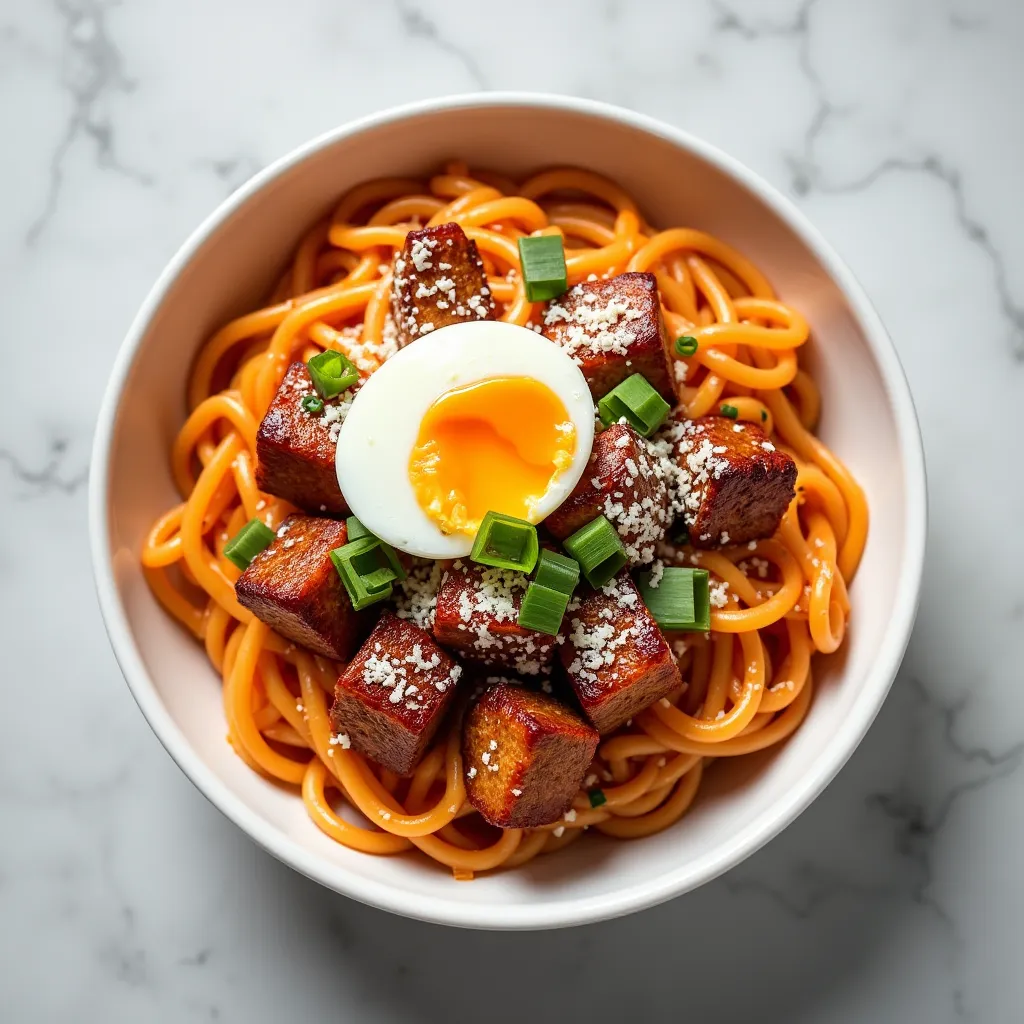 pin it
pin it
I still remember the first time I tried creating this gochujang pasta fusion dish. I was experimenting in my kitchen after returning from a trip to Seoul, where I'd fallen in love with the complex flavors of Korean cuisine. The bottle of gochujang in my pantry had been calling to me, and I wondered how it would work with pasta instead of the traditional rice. The result was nothing short of magical - the spicy, sweet, and umami-rich paste created this incredibly addictive sauce that coated each strand of spaghetti perfectly. Adding the crispy pork belly gave it substance and a wonderful textural contrast, while the soft-boiled egg created this luscious richness when mixed in. It's become my signature dish when friends come over, and everyone always asks for the recipe.
Why I love this recipe
I absolutely adore this gochujang pasta recipe because it represents everything I love about modern cooking - it's fearless about crossing cultural boundaries to create something truly spectacular. The way the spicy-sweet gochujang sauce clings to each strand of pasta gives me that perfect umami satisfaction that's hard to find in more traditional pasta dishes. The crispy pork belly adds these little bursts of fatty, savory goodness that contrast beautifully with the soft noodles. And breaking into that jammy egg yolk? Pure magic as it mingles with the sauce to create an even more luxurious texture. It's also incredibly versatile - I can adjust the spice level, swap proteins, or make it vegetarian while still keeping that bold flavor profile intact. Plus, it's one of those dishes that looks and tastes like it took hours to make, but can be whipped up on a weeknight when I'm craving something special. It always reminds me that some of the best culinary experiences come from being willing to experiment and play with flavors.
What You Need From Your Kitchen
- Gochujang paste: The star ingredient that gives the dish its signature spicy, sweet, and umami flavor
- Pork belly: Cut into cubes and fried until crispy for a rich, savory topping
- Spaghetti: The base of the dish, cooked al dente to hold the sauce well
- Soft-boiled eggs: With jammy yolks that add creaminess when mixed into the pasta
- Green onions: Thinly sliced for a fresh, mild onion flavor and pop of color
- Parmesan cheese: Finely grated to add a salty, umami dimension to the dish
- Sesame oil: Adds a nutty flavor that complements the Korean flavor profile
Let's Make These Together
- Prep the ingredients
- Cube the pork belly, mince the garlic, slice the green onions, and measure out all sauce ingredients before you begin cooking. This ensures a smooth cooking process.
- Get the pasta just right
- Cook the spaghetti until al dente - it should have a slight bite to it. Remember to reserve some pasta water before draining, as it's essential for creating a silky sauce that clings to the noodles.
- Perfect the pork belly
- Take your time when cooking the pork belly. It should be golden brown and crispy on all sides, which usually takes about 5-7 minutes over medium-high heat. The rendered fat becomes the flavor base for your sauce.
- Balance the sauce
- The key to this dish is getting the right balance of spicy, sweet, and savory in the sauce. Start with the recommended amounts of gochujang, honey, and soy sauce, then taste and adjust before adding the pasta.
- Master the jammy egg
- For perfect soft-boiled eggs with set whites and jammy yolks, time them exactly 6.5 minutes in boiling water, then immediately transfer to an ice bath to stop the cooking process.
 pin it
pin it
Switch Things Up
I first made this gochujang pasta when I was craving something spicy but didn't want to order takeout again. I had some leftover pork belly from the weekend and a tub of gochujang that needed using. The combination was so incredible that it's now in my regular rotation! Sometimes I swap the pork belly for tofu when cooking for vegetarian friends - just make sure to press it well and fry until really crispy. The parmesan can be omitted if you want to keep it more authentically Korean, but I love how it adds another dimension of umami.
Perfect Pairings
This spicy gochujang pasta pairs wonderfully with cooling side dishes to balance the heat. Try serving it with a simple cucumber salad dressed with rice vinegar and sesame oil. For drinks, a light lager beer or a fruity soju cocktail complements the spicy flavors beautifully. If you want to round out the meal, kimchi makes a perfect authentic side dish that adds a tangy contrast, while a simple miso soup can provide a soothing counterpart to start the meal.
 pin it
pin it
Frequently Asked Questions
- → Can I make this dish vegetarian?
Absolutely! You can substitute the pork belly with extra-firm tofu (pressed and cubed) or king oyster mushrooms. Pan-fry them until crispy before proceeding with the sauce. For a fully vegan version, omit the parmesan cheese or use a plant-based alternative.
- → How spicy is this dish?
As written, this recipe has a medium spice level. Gochujang varies in spiciness by brand, so adjust according to your preference. For a milder version, reduce the gochujang to 1-2 tablespoons and omit the gochugaru. For extra heat, increase the gochugaru or add fresh chopped chilies.
- → Can I prepare any components ahead of time?
Yes! The soft-boiled eggs can be made up to 2 days in advance and stored (unpeeled) in the refrigerator. The pork belly can also be cooked ahead and reheated in a pan just before serving. The sauce comes together quickly and is best made fresh.
- → What if I can't find gochujang?
While gochujang has a unique flavor profile, you can create a substitute by mixing 2 tablespoons tomato paste, 1 tablespoon miso paste, 1 teaspoon cayenne pepper or red pepper flakes, and 1 teaspoon honey. It won't be exactly the same, but it will give you similar sweet-spicy-umami notes.
- → How do I get the perfect jammy egg yolk?
For that perfect soft-boiled egg with a jammy yolk as shown in the image, bring water to a full boil, then lower refrigerated eggs in gently. Cook for exactly 6.5 minutes, then immediately transfer to an ice bath. Let cool for about 2 minutes before peeling carefully under running water.
- → Can I use a different type of pasta?
Absolutely! While spaghetti works well for twirling and coating with sauce, you can use any pasta you prefer. Linguine, fettuccine, or even shorter shapes like penne would work nicely. Just be sure to cook to al dente and reserve some pasta water for the sauce.
Conclusion
This Spicy Gochujang Fusion Pasta brings together the best of Korean and Italian cuisines in one mouthwatering dish. The umami-rich gochujang pairs perfectly with al dente spaghetti, while the crispy pork belly adds texture and substance. The soft-boiled egg creates a creamy sauce when mixed in, and the fresh green onions cut through the richness beautifully. It's a bold, flavorful dish that's sure to impress anyone looking for something beyond traditional pasta recipes.
